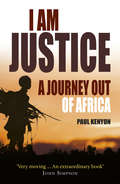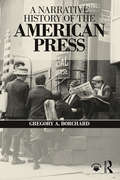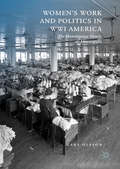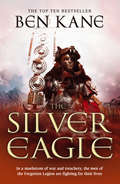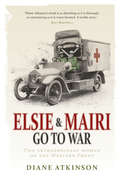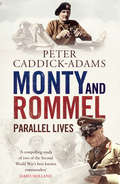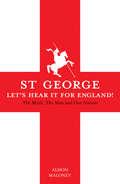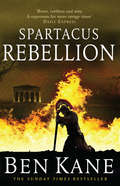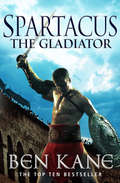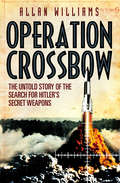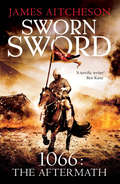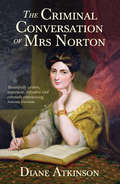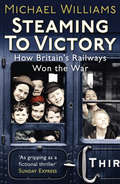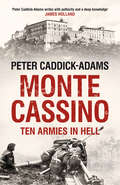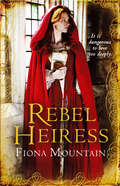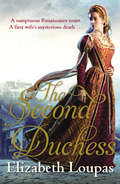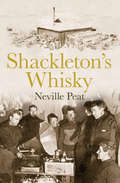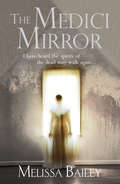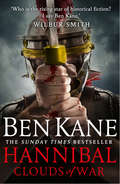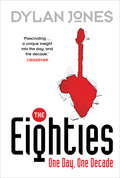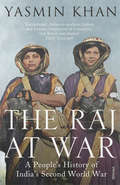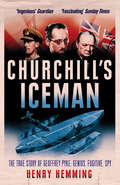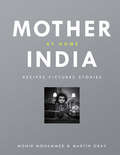- Table View
- List View
I Am Justice: A Journey Out of Africa
by Paul KenyonEighty miles off the Libyan coast water is leaking rapidly into the bottom of a dilapidated wooden boat. Twenty-seven men, crammed in side-by-side, desperately attempt to bail it out, but the boat is sinking. In the distance one of their number spots a ship and, forcing the last moments of life from the engine, they move towards it. But the crew refuses to allow them on board. Instead the men scramble onto the floats of a huge industrial tuna net, and watch as their boat rolls over and disappears into the heaving Mediterranean.Like tens of thousands of others Justice set off from his rural village with an idealised vision of an new life in England - the 'home' country - desperate just to earn his way and help his orphaned brother and sister left behind. During his long journey to the African coast, he's captured, jailed and tortured, before escaping and heading northwards again. Once in Tripoli he's duped into handing over his life savings for a trip in a wreck of a boat across miles of open sea to almost certain death. But there is also compassion here and he meets old and wise souls along the way. The tuna net is not the end of Justice's story. It is an extraordinary tale of courage, and an important account of a life caught between cultures, on the edge of survival.
A Narrative History of the American Press
by Gregory A. BorchardBeginning with the American Revolution and spanning over two hundred years of American journalism, A Narrative History of the American Press provides an overview of the events, institutions, and people who have shaped the press, from the creation of the First Amendment to today. Gregory A. Borchard’s introductory text helps readers develop an understanding of the role of the press in both the U.S. and world history, and how American culture has shaped—and been shaped by—the role of journalism in everyday life. The text, along with a rich array of supplemental materials available online, provides students with the tools used by both reporters and historians to understand the present through the past, allowing readers to use the history of journalism as a lens for implementing their own storytelling, reporting, and critical analysis skills.
Women's Work and Politics in WWI America: The Munsingwear Family of Minneapolis
by Lars OlssonBy World War I, the Northwestern Knitting Company was the largest workplace for gainfully employed women in Minnesota and the largest garment factory in the United States. Lars Olsson investigates the interplay of class, gender, marital status, ethnicity, and race in the labor relations at the factory, illuminating the lives of the women who worked there. Representing thirty nationalities, particularly Scandinavian, the women worked long hours for low pay in roles that were strictly divided along ethnic and gendered lines, while the company directors and stockholders made enormous profits off of their labor. Management developed paternal strategies to bind the workers to the company and preempt unionization, including bonus programs, minstrel shows, and a pioneering industrial welfare program. With the US entry into the war, the company was contracted to produce underwear for soldiers, and management expanded the metaphor of "the Munsingwear Family" to construct not just company loyalty, but national loyalty. This book sheds new light on women's labor in WWI and the lives of textile workers in the United States.
Women's Work and Politics in WWI America: The Munsingwear Family of Minneapolis
by Lars OlssonBy World War I, the Northwestern Knitting Company was the largest workplace for gainfully employed women in Minnesota and the largest garment factory in the United States. Lars Olsson investigates the interplay of class, gender, marital status, ethnicity, and race in the labor relations at the factory, illuminating the lives of the women who worked there. Representing thirty nationalities, particularly Scandinavian, the women worked long hours for low pay in roles that were strictly divided along ethnic and gendered lines, while the company directors and stockholders made enormous profits off of their labor. Management developed paternal strategies to bind the workers to the company and preempt unionization, including bonus programs, minstrel shows, and a pioneering industrial welfare program. With the US entry into the war, the company was contracted to produce underwear for soldiers, and management expanded the metaphor of "the Munsingwear Family" to construct not just company loyalty, but national loyalty. This book sheds new light on women's labor in WWI and the lives of textile workers in the United States.
The Silver Eagle: (The Forgotten Legion Chronicles No. 2) (The Forgotten Legion Chronicles #2)
by Ben KaneThe Forgotten Legion fought against almighty odds at the very edge of the known world - and lost.Now Brennus the Gaul, Tarquinius the Etruscan soothsayer and Romulus, bastard son of a Roman nobleman, are prisoners of Parthia. They dream of escape, but in the brutal fighting which lies ahead, only two will survive.Meanwhile, Fabiola, Romulus's twin sister, is caught up in the vicious eddies of Roman politics. Hunted by slave catchers she flees, hoping to find her lover, Brutus, bound for Alexandria with Caesar.Ben Kane's brilliant second novel plunges his characters into a cauldron of war and terror, as Caesar and the Roman Republic hurtle towards their day of reckoning.
Elsie and Mairi Go to War: Two Extraordinary Women on the Western Front
by Dr Diane AtkinsonWhen they met at a motorcycle club in 1912, Elsie Knocker was a thirty year-old motorcycling divorcee dressed in bottle-green Dunhill leathers, and Mairi Chisholm was a brilliant eighteen-year old mechanic, living at home and borrowing tools from her brother. Little did they know, theirs was to become one of the most extraordinary stories of the First World War.In 1914, they roared off to London 'to do their bit', and within a month they were in the thick of things in Belgium driving ambulances to distant military hospitals. Frustrated by the number of men dying of shock in the back of their vehicles, they set up their own first-aid post on the front line in the village of Pervyse, near Ypres, risking their lives working under sniper fire and heavy bombardment for months at a time. As news of their courage and expertise spread, the 'Angels of Pervyse' became celebrities, visited by journalists and photographers as well as royals and VIPs. Glamorous and influential, they were having the time of their lives, and for four years, Elsie and Mairi and stayed in Pervyse until they were nearly killed by arsenic gas in the spring of 1918. But returning home and adjusting to peacetime life was to prove even more challenging than the war itself.
Monty and Rommel: Parallel Lives
by Peter Caddick-AdamsTwo men came to personify British and German generalship in the Second World War: Bernard Montgomery and Erwin Rommel. They fought a series of extraordinary duels across several theatres of war which established them as two of the greatest captains of their age. Our understanding of leadership in battle was altered for ever by their electrifying personal qualities. Ever since, historians have assessed their outstanding leadership, personalities and skill.The careers of both began on the periphery of the military establishment and represent the first time military commanders proactively and systematically used (and were used by) the media as they came to prominence, first in North Africa, then in Normandy. Dynamic and forward-thinking, their lives also represent a study of pride, propaganda and nostalgia. Caddick-Adams tracks and compares their military talents and personalities in battle. Each brought something special to their commands. Rommel's breathtaking advance in May-June 1940 was nothing less than inspired. Montgomery is a gift for leadership gurus in the way he took over a demoralised Eighth Army in August 1942 and led it to victory just two months later. This compelling work is both scholarly and entertaining and marks the debut of a major new talent in historical biography.
St George: Let's Hear it For England!
by Alison MaloneyPope Gelasius, who canonized St George in 494, described him as one of those 'whose names are rightly reverenced among us, but whose actions are known only to God.' The story of England's Patron Saint is so encased in myth and legend that the truth of his remarkable life is unknown to the great majority of us.In many ways the attitude of the English, reflects the many contradictions in the story of St George and the growth of his legend worldwide. A Christian martyr, murdered by a Roman emperor in Palestine, he is a legendary dragon-slayer who saved a virgin princess from sacrifice - but not before insisting her entire town converts to Christianity. Yet he is also the model for mythical Islamic hero Al Khidr. He is the Patron Saint of England but never set foot on English soil and the legend of his knightly deeds came from the imagination of a bishop in Italy. In recent years, through national pride more than religious fervour, the popularity of St George's Day has risen sharply, with more parades, parties and pub get-togethers than we saw in the latter half of the twentieth century.
Spartacus: (Spartacus 2) (Spartacus #2)
by Ben KaneHe marches to freedom - or to bloody war. The epic story of Spartacus the legendary gladiator. From the Sunday Times bestselling author of Hannibal: Enemy of Rome and Spartacus: The Gladiator.The mighty slave army, led by Spartacus, has crushed all before it, scattering the legions of Rome. Now invincible, he marches towards the Alps and freedom.But storm clouds are growing on the horizon. Crassus, the richest man in Rome, has raised an army to rival Spartacus, and there are murmurings of rebellion in Spartacus’ own army.Spartacus, on the brink of glory, must make a crucial decision - to go forward over the Alps to freedom, or back to face the might of Rome and try to break its power forever.'Compulsive, relentless ... vividly recounted in muscular prose' Daily Telegraph'A brutal, blood-spattered novel' BBC History Magazine
Spartacus: (Spartacus 1) (Spartacus #1)
by Ben KaneThe first of two epic novels which tell the story of one of the most charismatic heroes history has ever known - Spartacus, the gladiator slave who took on and nearly defeated the might of Rome, during the years 73-71 BC.Historically very little is known about Spartacus. We know that he came from Thrace, a land north of Greece, that he once fought in the Roman legions and that, during two fateful years, he led a slave army which nearly brought Rome to its knees.In Ben Kane's brilliant novel, we meet Spartacus as he returns to Thrace, ready to settle down after a decade away. But a new king has usurped the throne. Treacherous and violent, he immediately seizes Spartacus and sells him to a Roman slave trader looking for new gladiators.The odyssey has begun which will see Spartacus become one of the greatest legends of history, the hero of revolutionaries from Karl Marx to Che Guevara, immortalised on screen, and now brought to life in Ben Kane's great bestseller - a novel which takes the story to its halfway point and is continued in Spartacus: Rebellion.Ben Kane was born in Kenya and raised there and in Ireland. He studied veterinary medicine and University College, Dublin, but after that he travelled the world extensively, indulging in his passion for ancient history. He lives in North Somerset with his wife and two young children.
Operation Crossbow: The Untold Story of the Search for Hitler’s Secret Weapons
by Allan WilliamsThe story of the photographic intelligence work undertaken from a country house at Medmenham, Buckinghamshire, is one of the great lost stories of the Second World War . At its peak in 1944, almost 2,000 British and American men and women worked at the top-secret Danesfield House, interpreting photographs - the majority stereoscopic so they could be viewed in 3D - to unlock secrets of German military activity and weapons development. Millions of aerial photographs were taken by Allied pilots, flying unarmed modified Spitfires and Mosquitos on missions over Nazi Europe. it was said that an aircraft could land, the photographs be developed and initial interpretation completed within two hours - marking the culmination of years of experiments in aerial intelligence techniques.Their finest hour began in 1943, during the planning stages of the Allied invasion of Europe, when Douglas Kendall, who masterminded the interpretation work at Medmenham, led the hunt for Hitler's secret weapons. Operation Crossbow would grow from a handful of photographic interpreters to the creation of a hand-picked team, and came to involve interpreters from across the Medmenham spectrum, including the team of aircraft specialists led by the redoubtable Constance Babington Smith. In November that year, whilst analysing photographs of Peenemunde in northern Germany, they spotted a small stunted aircraft on a ramp. This intelligence breakthrough linked the Nazi research station with a growing network of sites in northern France, where ramps were being constructed aligned not only with London, but targets throughout southern Britain.Through the combined skill and dedication of the Crossbow team and the heroism of the Allied pilots, throughout late 1943 and 1944 V-weapon launch sites were located and through countermeasures destroyed, saving hundreds of thousands of lives, and changing the course of the war.Operation Crossbow is a wonderful story of human endeavour and derring-do, told for the first time.
Sworn Sword: 1066 - The Aftermath (The Conquest #1)
by James AitchesonJanuary 1069. Less than three years have passed since Hastings and the death of the usurper, Harold Godwineson. In the depths of winter, two thousand Normans march to subdue the troublesome province of Northumbria. Tancred a Dinant, an ambitious and oath-sworn knight and a proud leader of men, is among them, hungry for battle, for silver and for land.But at Durham the Normans are ambushed in the streets by English rebels. In the battle that ensues, their army is slaughtered almost to a man. Badly wounded, Tancred barely escapes with his life. His lord is among those slain.Soon the enemy are on the march, led by the dispossessed prince Eadgar, the last of the ancient Saxon line, who is determined to seize the realm he believes is his. Yet even as Tancred seeks vengeance for his lord's murder, he finds himself caught up in secret dealings between a powerful Norman magnate and a shadow from the past.As the Norman and English armies prepare to clash, Tancred begins to uncover a plot which harks back to the day of Hastings itself. A plot which, if allowed to succeed, threatens to undermine the entire Conquest. The fate of the Kingdom hangs in the balance ...
The Criminal Conversation of Mrs Norton: Victorian England's Scandal Of The Century And The Fallen Socialite Who Changed Women's Lives Forever
by Dr Diane AtkinsonCaroline Norton, born in 1808, was a society beauty, poet and pamphleteer. Her good looks and wit attracted many male admirers, first her husband, the Honourable George Norton, and then the Prime Minister, Lord Melbourne.After years of simmering jealousy, George Norton accused Caroline and the Prime Minister of a ‘criminal conversation’ (adultery) resulting in a trial referred to as ‘the scandal of the century’. Cut off and bankrupted by George Norton, she went on to become one of the most important figures in changing the law for wives and mothers.
Steaming to Victory: How Britain's Railways Won the War
by Michael WilliamsIn the seven decades since the darkest moments of the Second World War it seems every tenebrous corner of the conflict has been laid bare, prodded and examined from every perspective of military and social history. But there is a story that has hitherto been largely overlooked. It is a tale of quiet heroism, a story of ordinary people who fought, with enormous self-sacrifice, not with tanks and guns, but with elbow grease and determination. It is the story of the British railways and, above all, the extraordinary men and women who kept them running from 1939 to 1945. Churchill himself certainly did not underestimate their importance to the wartime story when, in 1943, he praised ‘the unwavering courage and constant resourcefulness of railwaymen of all ranks in contributing so largely towards the final victory.’ And what a story it is. The railway system during the Second World War was the lifeline of the nation, replacing vulnerable road transport and merchant shipping. The railways mobilised troops, transported munitions, evacuated children from cities and kept vital food supplies moving where other forms of transport failed. Railwaymen and women performed outstanding acts of heroism. Nearly 400 workers were killed at their posts and another 2,400 injured in the line of duty. Another 3,500 railwaymen and women died in action. The trains themselves played just as vital a role. The famous Flying Scotsman train delivered its passengers to safety after being pounded by German bombers and strafed with gunfire from the air. There were astonishing feats of engineering restoring tracks within hours and bridges and viaducts within days. Trains transported millions to and from work each day and sheltered them on underground platforms at night, a refuge from the bombs above. Without the railways, there would have been no Dunkirk evacuation and no D-Day.Michael Williams, author of the celebrated book On the Slow Train, has written an important and timely book using original research and over a hundred new personal interviews.This is their story.
Monte Cassino: Ten Armies in Hell
by Peter Caddick-AdamsThe five-month Monte Cassino campaign in central Italy is one of the best-known European land battles of World War Two, alongside D-Day and Stalingrad. It has a particular resonance now, because Cassino, with its multitude of participating armies - most notably the American 5th Army under the controversial General Mark Clark - was perhaps the campaign of the Second World War that most closely anticipates the coalition operations of today, with its ever-shifting cast of players stuck in inhospitable, mountainous terrain, pursuing an objective set by unknowing politicians in distant capitals, where victory is difficult to define. Monte Cassino was characterised by the destruction of its world famous Abbey: in retrospect, considered an unjustifiable act of cultural vandalism by the allies.The audit trail of decision-making to destroy an icon as well known then as the Eiffel Tower or Lincoln Memorial, is a chilling reminder that similar decisions are still being made in Iraq and Afghanistan and indeed Libya. To this day, reversing normal prejudice, German troops are welcome in the abbey, having rescued its treasures from allied destruction in February 1944.Cassino was an unusual campaign for World War II in that its outcome was not reliant on sweeping movements or the use of tanks or aircraft - but by old-fashioned boots in the mud, whether capturing the town of Cassino after months of grinding urban warfare (a Stalingrad in miniature) or scrambling up the steep mountain to seize the heights and the religious complex on top of Monte Cassino. Monte Cassino Abbey was painstakingly rebuilt after the war (its baroque chapel remains incomplete) and is now a World Heritage site. An hour south of Rome, it is visited each year by up to one million tourists and pilgrims from around the world.
Rebel Heiress
by Fiona MountainBorn into a world seething with treachery and suspicion, Eleanor Goodricke grows up on the Somerset Levels just after the English Civil Wars, heiress to her late mother's estates and daughter of a Puritan soldier who fears for his brilliant daughter with her dangerous passion for natural history - and for butterflies in particular.Her reckless courage will take her to places where no woman of her day ever dared to go. Her fearless ambition will give her a place in history for all time. But it is her passionate heart which will lead her into a consuming love - and mortal peril.
The Flower Reader
by Elizabeth LoupasWith her dying breath, Mary of Guise entrusts a silver casket containing explosive secret papers to the young Scottish heiress, Rinette Leslie. She makes Rinette promise to keep the casket hidden and only to give it to Mary, Queen of Scots, now on her way home from France to ascend the throne.But Rinette makes a terrible mistake - she cannot resist showing it to her beloved young husband, before consigning the casket to its hiding place. This fatal decision will lead them into a maze of conspiracy and murder, in which they - and the beautiful castle by the sea, which is Rinette's inheritance - become the targets of ruthless men who seek to possess the casket at all costs.Unable to tell friend from foe at court, and desperate to protect the queen's secrets, Rinette has one powerful weapon which may save her - the ancient art of floramancy, through which she can interpret the language of flowers and sometimes predict the future. But if the flowers should stay silent, who can she trust then?
The Second Duchess
by Elizabeth LoupasA dazzling tale of love, sumptuous splendour and conspiracy in the Italian Renaissance court of Ferrara, from the brilliant author of The Flower Reader.Barbara of Austria is plain, quick-witted and sensible. She also desperately needs a husband, for unmarried at twenty-six, she is about to be packed off to a convent, like her sisters before her.So it is that she seizes what seems to be her last chance - a proposal of marriage from Alfonso d'Este, Duke of Ferrara, Lucrezia Borgia's grandson, clever, handsome, powerful - and widely believed to have murdered his first wife, Lucrezia de Medici.Barbara goes into her marriage clear-eyed, fascinated by her dangerous, enigmatic new husband - and increasingly - recklessly - driven to discover the truth about the death of his first duchess.
Shackleton's Whisky: The extraordinary story of an heroic explorer and twenty-five cases of unique MacKinlay's Old Scotch
by Neville PeatSir Ernest Shackleton could never have imagined his name being closely associated with whisky, certainly not in the title of a book. Rarely did he consume strong drink. On his expeditions, he tolerated a ‘mild spree’ at times of celebration. But that was all. Drinking to excess appalled him. From an early age, growing up in a teetotal home, he was wary of alcohol. How, then, must he have felt about signing an order for twenty-five cases of whisky — 300 bottles — for his 1907–09 British Antarctic Expedition?Shackleton’s Whisky follows the story of the Rare Old Highland Whisky taken south on his Nimrod expedition. It celebrates the extraordinary achievements of men exploring an extraordinary place. It dips into the human-interest stories of polar life in the ‘heroic era’ of Antarctic exploration. Shackleton once wrote of his interest in documenting ‘the little incidents that go to make up the sum of the day’s work, the humour and the weariness, the inside view of men on an expedition’. Here is one such account, based largely on what he wrote and said about the expedition and also on what the members of his expedition wrote, for most participants kept a diary or journal.Antarctic exploration and whisky, in their own way, are both steeped in history, maturity, endurance, character, and technology. Both have a worldwide following, millions of fans. Their pathways coincided on the British Antarctic Expedition 1907-09. With the recovery 100 years later of three cases of Scotch from icy entombment under the hut at Cape Royds and the subsequent return of three bottles to Scotland for sampling, analysis and a near-magical replication, the relationship of whisky and Antarctic exploration came sharply into focus, making a unique odyssey to the end of the Earth and back.
The Medici Mirror
by Melissa Bailey‘I have heard, but not believed, the spirits of the dead may walk again…’A hidden roomWhen architect Johnny Carter is asked to redesign a long-abandoned Victorian shoe factory, he discovers a hidden room deep in the basement. A dark, sinister room, which contains a sixteenth-century Venetian mirror.A love in dangerJohnny has a new love, Ophelia, in his life. But as the pair’s relationship develops and they begin to explore the mystery surrounding the mirror, its malign influence threatens to envelop and destroy them. A secret history The mirror’s heritage dates back to the sixteenth century, and the figure of Catherine de Medici – betrayed wife, practitioner of the occult, and known as the Black Queen. The Medici Mirror is a haunting story of jealousy, obsession, and murder, perfect for fans of Kate Mosse and Barbara Erskine; a story about the ability of the past to influence the present and of love’s power to defeat even the most powerful of curses.
Hannibal: Clouds of War (Hannibal Ser. #3)
by Ben KaneAs Rome's war with Carthage continues, two friends - now on opposing sides - confront each other in one of the most brutal sieges of all time. A new Hannibal novel by the Sunday Times bestselling author of The Forgotten Legion series.213 BC. Syracuse. Under the merciless Sicilian sun, a city is at war.Outside the walls, a vast Roman army waits. Yet the city’s incredible defences, designed by Archimedes, mean that Syracuse will not be taken easily. A veteran of the bitter war since its beginning, Quintus is ready to give his life in the service of the Republic. But dangers face him from within his own ranks as well as from the enemy - who include his former friend, the Carthaginian, Hanno. Hanno has been sent by his general Hannibal to aid Syracuse in its fight against Rome. Pledged to bring death to all Romans, he is diverted from his mission by the discovery of Quintus’ sister Aurelia, a captive within the city.Two friends on opposing sides. A woman caught between them. They are about to meet in one of the most brutal sieges of all time.Who will survive?
The Eighties: One Day, One Decade
by Dylan JonesOne Day: Saturday 13 July 1985, nearly two billion people woke up with one purpose. Nearly a third of humanity knew where they were going to be that day. Watching, listening to, attending: Live Aid. One Decade: Britain in the Eighties was different. The culture was different, the politics were different, and our engagement with the world was different. And it was just one day in 1985 that showed how different it was.In One Day, One Decade Dylan Jones tells the story of the Eighties through that day at Wembley, sweeping backwards to the end of the Seventies, and forward to the start of the Nineties. It draws on his personal reminiscences and perspective of music, media, fashion, politics and all forms of pop culture to frame the decade.This is a big book but not a exhaustive and dry social history. Live Aid was the decade’s pinch point, when a nation's attitudes and expectations were somehow captured and changed forever. The author suggests that before Live Aid, Britain was one place, and after Live Aid it was another.Britain in the Eighties was a juxtaposition of militancy and profligacy, a country where industry was being broken down, societies were being demolished, and unemployment became an inevitable lifestyle choice: yet the Eighties was also the apotheosis of pop culture, a decade where entertainment, opinion and subjectivity were more important than ever before.Dylan Jones was at the heart of the 1980s editing the seminal magazines i-D and The Face. He was one of the Blitz Kids and was both a commentator and one of the style-makers of the time. This is a controversial book, a story told from the inside by one who was at the centre of events.
The Raj at War: A People’s History of India’s Second World War
by Yasmin KhanYasmin Khan presents the hidden and sometimes overlooked history of India at war, and shows how mobilisation for the war introduced seismic processes of economic, cultural and social change - decisively shaping both the international war effort, the unravelling of the empire and India's own political and economic trajectory.
Churchill's Iceman: The True Story of Geoffrey Pyke: Genius, Fugitive, Spy
by Henry HemmingFrom the author of the Sunday Times bestseller, M: Maxwell Knight, MI5's Greatest SpymasterIn the World War II era, Geoffrey Pyke was described as one of the world's great minds. An inventor, adventurer and polymath, he was an unlikely hero of both world wars. He earned a fortune on the stock market, founded an influential pre-school, and is seen as the father of the U.S. Special Forces. In 1942, he convinced Winston Churchill to build an aircraft carrier out of reinforced ice. He escaped from a German WWI prison camp, wrote a bestseller, and aided Republicans in the Spanish Civil War. He even launched a private attempt to avert the outbreak of the Second World War by sending into Nazi Germany a group of pollsters disguised as golfers.And he may have been a Russian spy.70 years after his death, Henry Hemming reveals Pyke's astonishing story in full: his brilliance, his flaws, and his life of adventures, ideas, and secrets.
Mother India at Home: Recipes Pictures Stories
by Monir Mohammed Martin GrayMother India at Westminster Terrace in Glasgow, has been an institution since 1996 and specialises in dishes such as ginger and green chilli fish pakora, seasoned Scottish haddock with Puy lentils, and Delhi-style Scottish lamb, all cooked fresh to order, reflecting Mother India owner Monir Mohammed’s commitment to cooking quality Indian food without pandering to the British taste for inauthentic korma or masala. The strategy has been hugely popular, allowing expansion to five outlets, including tapas, take- aways and a Mother India Cafe in Edinburgh. Mother India is regularly ranked in Herald restaurant critic Ron MacKenna’s top 10 Scottish restaurants.The book will incorporate a first person account of Monir’s personal culinary journey, with a photo essay of the life of one of the world's great Indian restaurants as an integral cog in the cultural melting pot of a modern British city. Alongside this will be a collection of recipes, some of which are signature Mother India dishes, and others designed specifically for home cooking. Each recipe will draw upon Monir's story: his beginnings as a boy from a British Asian family who started working in restaurants at 14 and his pivotal stay in the Punjab in his late teens where he learned the ancient principles of Indian home cooking from scratch. The book will tell the story of the risks he took to build a personal, authentic style of Indian cooking. There are human stories running through the recipes as well: Hajra Bibi's Salmon was inspired by a dish his mother (Hajra Bibi) used to make them as children.
